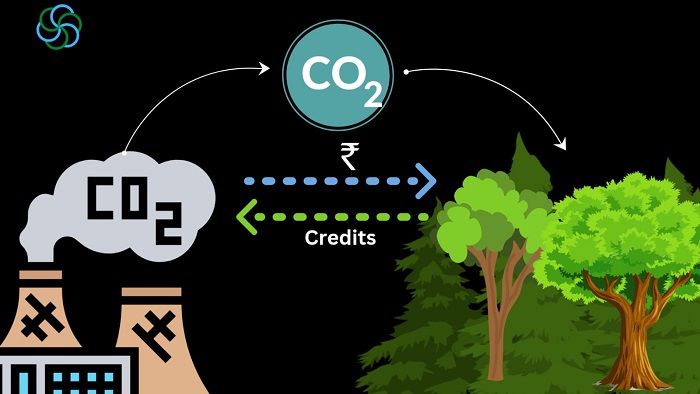Picture an earth where urban landscapes intertwine with verdant oases, every bus or train runs on unblemished energy, and industries conduct business with negligible ecological impact. Such an image isn’t a pipe dream—it’s a tangible blueprint for sustainable progression that we need to relentlessly pursue. And an exciting instrument that is contributing to this mission is Carbon Credits.
“By understanding and harnessing the benefits of carbon credits, we can unlock opportunities for environmental, economic, and social progress.“
Carbon credits provide a market-based mechanism to incentivize emissions reduction and fund projects that contribute to a sustainable future. They can help in reducing greenhouse gas emissions and promoting sustainable development. They are a form of tradable permits that represent a reduction or removal of one metric ton of carbon dioxide (or its equivalent) from the atmosphere.
These credits are generated through carbon offset projects, which are initiatives aimed at reducing emissions or removing carbon dioxide from the atmosphere. By understanding and harnessing the benefits of carbon credits, we can unlock opportunities for environmental, economic, and social progress. They are playing an increasingly important role in India, and they are expected to play an even greater role in the years to come.
Work of carbon credits
Indian Carbon Credit market is a voluntary market, which means that there is no government regulation requiring companies to buy or sell carbon credits. However, many companies are choosing to participate in the market because it is a way for them to meet their climate change goals.
When a company buys a carbon credit, it is essentially buying the right to emit one ton of carbon dioxide or its equivalent. The company can then use this credit to offset its own emissions. For example, if a company emits 100 tons of carbon dioxide, it can buy 100 carbon credits to offset those emissions.
Benefits of carbon credits
For starters, they provide a standard, tradeable unit that encapsulates the ecological ramifications of a company’s activities. This system brings our individual and global carbon footprints into sharp focus, spurring efforts towards cleaner operations.
The allure of profit from carbon credits has drawn the interest of Indian entrepreneurs and overseas investors alike, sparking a dynamic market that contributes significantly to India’s economy. As of 2022, the value of India’s carbon market exceeded $1 billion, with promising expansion projected in the years ahead. This green infusion of capital is spurring technological progress and nurturing innovative thinking within India’s renewable energy sector.
Uses of carbon credits in India
In India, carbon credits are playing an increasingly important role in promoting sustainable development. The Indian government has set a target of reducing its greenhouse gas emissions by 33-35% below 2005 levels by 2030. Carbon credits can help India to meet this target by providing a way for businesses to reduce their emissions without having to make major changes to their operations.
“Number of carbon credit projects underway in India which include renewable energy projects, energy efficiency projects, and reforestation projects.“
They are also providing a boost to our economy, the Indian carbon market is expected to grow to $10 billion by 2030. This growth will create jobs and generate revenue for the government. There are a number of carbon credit projects underway in India which include renewable energy projects, energy efficiency projects, and reforestation projects.
ALSO READ: Embrace India’s Green Movement: Top Environmental Products on Amazon India”
Challenges of using carbon credits
However, it’s important to remember that while carbon credits are a compelling solution, they aren’t a universal fix-all. They’re one part of an extensive strategy to combat climate change, and their success depends on robust regulatory structures, precise emissions monitoring, and careful supervision to avoid misuse.
The road towards sustainability is intricate and demanding, yet the rise of carbon credits provides a beacon of optimism. It’s evidence of our ability to harmonise economic development with environmental conservation. India’s story shows that this equilibrium isn’t just feasible—it’s profitable and sustainable. Ultimately, our collective dedication to innovative approaches will dictate if our vision of a sustainable future remains elusive or becomes a tangible reality.
There are a number of challenges to using carbon credits.
- Lack of transparency and regulations as the market is still relatively new.
- Risk of fraud and abuse
- Risk that carbon credits will not actually reduce greenhouse gas emissions.
“Realising the full potential of carbon credits requires concerted efforts from governments, businesses, and individuals“
Conclusion
Carbon credits present a promising solution for mitigating climate change and fostering sustainable development. Along with environmental, economic, and social progress, Carbon credits are contributing to emissions reductions, preserving ecosystems, creating economic opportunities, and empowering communities. However, realising the full potential of carbon credits requires concerted efforts from governments, businesses, and individuals. It is essential to embrace carbon credits as a key strategy in tackling climate change and shaping a sustainable and resilient future.
AUTHOR

Shalin Sheth, Founder & Managing Director, Advait Infratech
The views expressed here are personal and do not necessarily represent those of the organisation or the publication
FOLLOW US ON


